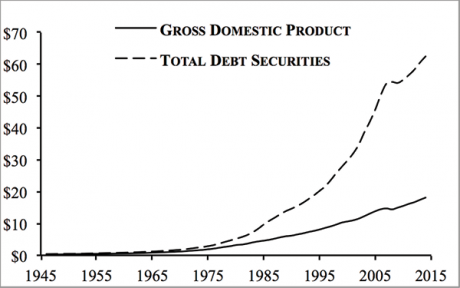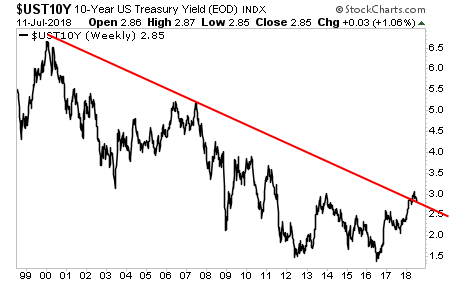The Everything Bubble Hits A New Record… Right As Bonds Begin To Drop
The Everything Bubble hit a new record in 1Q18… with total global Debt to GDP exceeding 318%.
All told, the world now has some $247 TRILLION in debt. As I explain in my bestselling book The Everything Bubble: The Endgame For Central Bank Policy, when the US abandoned the Gold Standard completely in 1971, it opened the door to a massive debt expansion.
Why?
Because from that point onwards, the US would be paying its debt solely in US dollars… dollars that the Fed could print at any time. What followed was truly parabolic debt growth, with total US debt growing exponentially relative to its GDP.
(Click on image to enlarge)

By the way, that chart is denominated in TRILLIONS of US Dollars.
By the time the mid-90s rolled around, the US financial system was so saturated with debt the Federal Reserve opted to start intentionally creating asset bubbles to stop debt deflation.
The late ‘90s was the Tech Bubble.
When that burst, the Fed opted to create a bubble in Housing… a more senior asset class.
As a result, in the mid-00s we had the Housing Bubble.
When that bubble burst, the Fed opted to create a bubble in US Treasuries… the MOST senior asset class in the entire system, representing the risk-free rate of return against which all risk is valued.
Put another way, the Fed opted to create a bubble in the bedrock of the financial system. By doing this, literally, EVERYTHING went into bubble-mode, hence my coining the term The Everything Bubble back in 2014.
Which brings us to today.
Yields on Treasuries have broken their long-term 20-year trendline.
(Click on image to enlarge)

This is a MAJOR problem. The entire debt bubble requires interest rates to remain LOW in order for it to be maintained. If bond yields continue to rise, bond prices will collapse.
If bond prices collapse, the Everything Bubble bursts.
The Fed now has a choice… continue to support stocks or defend bonds… and unfortunately for stock investors, it’s going to have to choose bonds.
Put another way, I believe there is a significant chance the Fed will let the stock market collapse in order to drive capital BACK into the bond market to force bond yields down.
Yes, the Fed has screwed up with monetary policy. And it is doing so intentionally to try to sustain the Debt Bubble. Currently, the downside target for the collapse is in the 2,300-2,450 range.
(Click on image to enlarge)

We are already preparing our clients with a 21-page investment report that shows them FOUR investment strategies that will protect their capital when and if a stock market crash hits.
It’s ...
more



Interesting article. I wanted to point out that your chart lists total debt securities as being in the 70 trillion range. As far as I know, that number refers to total world debt, and the Fed's ability to print money doesn't impact those debts (or any debt other than federal USA government debt). Also, the usage of "intentionally" creating bubbles was a little misleading, in my mind. This is because the whole point of monetary policy is to modulate interest rates to help control capital flows for business investment. When interest rates are lowered, it causes easier business growth, since capital is cheaper. You're right to say that higher rates will cause stock market prices to decline, but that's not an inherently bad thing. It's just that higher interest rates make bonds more relatively attractive, increasing demand for them. In a finite market, these currents are normal, and ongoing. Thanks for sharing!
Bank of America accused the Fed of intentionally creating bubbles by deilberately mispricing risk.
Debt replaced gold as wealth. One man's debt is another man's income. But it would seem the Fed would defend bonds over stocks as the author asserts, since bonds have replaced gold as wealth.